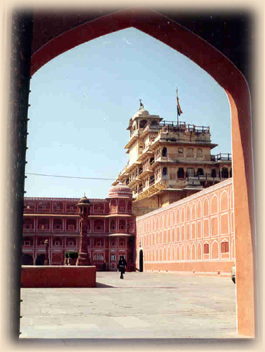|
The City Palace is located in Pink City, Jaipur and has an imposing blend of traditional Rajasthan and Mughal architecture. The vast palace complex occupies one seventh of the walled city of
Jaipur. The City Palace was originally built by Maharaja Jai Singh II of the Kachhwaha clan of
Rajputs. Later several additions were made to the palace complex by many of his successors. The City Palace is the core of the royal residences in
Jaipur.
The former Maharaja still
resides in a part of it, but the rest of the part serves as a
museum.
Architecture of the City
Palace
The City Palace complex is divided into a series of courtyards, sprawling gardens and buildings. The main places inside the complex are the Chandra Mahal, Mubarak Mahal, Badal Mahal and Shri Govind Devji Temple.
On entering the palace complex and in the first courtyard lies the Mubarak
Mahal, the palace of welcome or reception. Earlier it was used as a
reception centre where the persons used to come
|
 |
|
to visit the Maharaja. The Mubarak Mahal was built by Maharaja Madho Singh II in the late 19th century. The Mubarak Mahal now contains the textile section of the Maharaja Sawai Man Singh II Museum. This museum has a wide array of royal costumes, some very exquisite and precious Pashmina Shawls, Banarsi Silk Saris, Sanganeri prints and folk embroidery. An unusual display is that of
the clothes worn by Maharaja Sawai Madho Singh I (1750-68).
There is a magnificent gateway with a grand door in brass opening to a stately courtyard. In this courtyard lies the Diwan-I-Khas or 'Hall of Private Audience'. It is an open hall with a double row of columns with scalloped arches. On display are the two largest silver vessels in the world which are also placed in the Guiness Book of World Records. These vessels were used to carry water from the holy Ganges by Madho Singh II on his journey to England. 242.7 kilograms of silver was required to cast each vessel, which could contain 8182 gallons of water.
Across the paved square lies the Diwan-E-Aam or the Hall of Public Audience. This palace has intricate decorations in deep red and gold, Afghan and Persian carpets,
textiles, miniature paintings, precious manuscripts and palanquins. At the other corner is the gateway Ridhi Sidhi Pol, with four small doorways decorated with motifs depicting the four seasons. The Maharani Palace, the palace of the Queen now has a vast display of the Rajput weapons. The weapons are as old as 15th century and are still in a remarkable state of preservation. One of the main weapon is the scissor-action dagger. Other weapons are the protective chain armours, pistols, jewelled and ivory handled swords, a belt sword, small and assorted cannons, guns, poison tipped blades and gun powder pouches.
To the north west lies the graceful seven storeyed Chandra Mahal, or the Moon Palace, home of the present Maharaja of Jaipur, Bhavani Singh. This palace provides a fine view of the gardens and the city. Paintings, floral decorations, mirror walls and ceilings in the traditional style adorn the palace. Each storey has a distinctive name and is a place of sheer beauty and luxury. Chandra Mahal, the main royal residence, is topped by Mukut Mahal, an elegant pavilion with a curvilinear roof. The ground and first floor of the Chandra Mahal form the Maharaja Sawai Man Singh II Museum.
"Sukh Nivas" or the "Hall of Rest" holds the drawing and dining room of the Maharaja, furnished with Mughal miniatures, European silver and glass dining tables and peep holes decorated with gold leafs, for ventilation. Sukh Niwas has been painted in Wedgewood blue, ornamented with white lining. On the fourth floor of the Chandra Mahal lies the "Shobha Nivas" or "Hall of Beauty". This palace has mirror encrusted walls with exquisite blue tiled dadoes and glittering gold leaf and mica decoration. When the room was lit after dark the Maharajas could enjoy a breathtaking spectacle of the room bursting into a thousand flickering images. Through the glass panes you may view the Sri Govind Devji Temple, the first structure built by Sawai Jai Singh in Jaipur. The Shobha Nivas and the Sukh Nivas are still occupied by the present Maharaja. On the fifth floor lies the "Chhavi Nivas" or Hall of Images. This palace was the Maharajas retreat in the rainy season and still has a polished floor of eggshell stucco and blue and white painted walls.
Opposite the Chandra Mahal lies the 'Badal Mahal'. The Govind Devji Temple stands in the middle of the Chandra Mahal and the Badal Mahal. A delightful system of fountains is placed in the middle of the paved path between the Chandra Mahal and the Badal Mahal. Another integral part of the palace complex is the Hawa Mahal.
The City Palace is open between 0930 to 1630 hrs.
Entrance Fees
The entrance fees of City Palace, Jaipur is Rs. 150 for Foreign Tourists. |